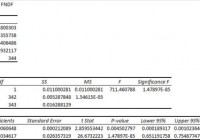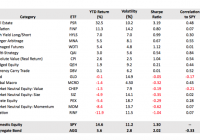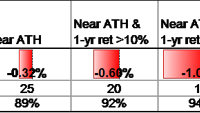FNDF Has Great Risk Factors And Enough Liquidity, But I Really Dislike The Cash Position
Summary I’m taking a look at FNDF as a candidate for inclusion in my ETF portfolio. The extremely low correlation with other major funds (like SPY) is great and holds up despite a decent time frame and high volume of trades. The expense ratio is a bit high for my liking and is combined with a fairly large position in cash. Investors should treat cash in an ETF as a savings account that charges them an expense ratio instead of paying interest. I’m not assessing any tax impacts. Investors should check their own situation for tax exposure. Investors should be seeking to improve their risk adjusted returns. I’m a big fan of using ETFs to achieve the risk adjusted returns relative to the portfolios that a normal investor can generate for themselves after trading costs. I’m working on building a new portfolio and I’m going to be analyzing several of the ETFs that I am considering for my personal portfolio. One of the funds that I’m considering is the Schwab Fundamental International Large Company Index ETF (NYSEARCA: FNDF ). I’ll be performing a substantial portion of my analysis along the lines of modern portfolio theory, so my goal is to find ways to minimize costs while achieving diversification to reduce my risk level. What does FNDF do? FNDF attempts to track the total return of the Russell Fundamental Developed ex-U.S. Large Company Index. Normally at least 90% of the assets are invested in funds included in this index, but there appears to be some leeway under unusual market conditions. FNDF falls under the category of “Foreign Large Value.” Does FNDF provide diversification benefits to a portfolio? Each investor may hold a different portfolio, but I use the SPDR S&P 500 Trust ETF (NYSEARCA: SPY ) as the basis for my analysis. I believe SPY, or another large cap U.S. fund with similar properties, represents the reasonable first step for many investors designing an ETF portfolio. Therefore, I start my diversification analysis by seeing how it works with SPY. I start with an ANOVA table: (click to enlarge) The correlation is only 82%, which is very solid for modern portfolio theory. Extremely low levels of correlation are wonderful for establishing a more stable portfolio. I consider anything under 50% to be extremely low. However, when I see those values it usually comes with issues, such as low average volume, which can create distorted statistics. For an ETF with around 184,000 shares trading hand each day, the 82% is very impressive. Standard deviation of daily returns (dividend adjusted, measured since August 2013) The standard deviation is pretty good. For FNDF it is 0.8055%. For SPY, it is 0.6891% for the same period. SPY usually beats other ETFs in this regard. If an ETF is only 0.10% to 0.15% over SPY with heavy trading volume it is doing fairly well for stability. Mixing it with SPY I also run comparisons on the standard deviation of daily returns for the portfolio assuming that the portfolio is combined with the S&P 500. For research, I assume daily rebalancing because it dramatically simplifies the math. With a 50/50 weighting in a portfolio holding only SPY and FNDF, the standard deviation of daily returns across the entire portfolio is 0.7135%. With 80% in SPY and 20% in FNDF, the standard deviation of the portfolio would have been 0.6898%. If an investor wanted to use FNDF as a supplement to their portfolio, the standard deviation across the portfolio with 95% in SPY and 5% in FNDF would have been 0.6881%. Why I use standard deviation of daily returns I don’t believe historical returns have predictive power for future returns, but I do believe historical values for standard deviations of returns relative to other ETFs have some predictive power on future risks and correlations. Yield & Taxes The distribution yield is 0.50%. Retirees seeking yields won’t find them here, but the low correlation still looks good for investors that don’t need strong yields. I’m not a CPA or CFP, so I’m not assessing any tax impacts. Expense Ratio The ETF is posting 0.32% for an expense ratio. I want diversification, I want stability, and I don’t want to pay for them. The expense ratio on this fund is higher than I want to pay for equity securities, but not high enough to make me eliminate it from consideration. Market to NAV The ETF is at a 0.85% premium to NAV currently. Premiums or discounts to NAV can change very quickly so investors should check prior to putting in an order. I don’t want to pay a premium over 0.2%, and this premium has persisted despite a respectable amount of daily volume. I don’t see these premiums as sustainable over the long term, so I would be concerned about entering a position without seeing the premium drop first. Largest Holdings The diversification within the ETF is pretty good, so long as we only look at the equity securities. (click to enlarge) I’m not big on the holdings including a 10% value for U.S. dollars. I have nothing against dollars, but I already have them in my checking and savings account. Neither of those accounts are charging me an expense ratio. Conclusion I’m currently screening a large volume of ETFs for my own portfolio. The portfolio I’m building is through Schwab, so I’m able to trade FNDF with no commissions. I have a strong preference for researching ETFs that are free to trade in my account, so most of my research will be on ETFs that fall under the “ETF OneSource” program. For the level of liquidity, the low correlation is great. However, I’m not comfortable investing at a significant premium to NAV and with the high volumes of trades the bid-ask spread may be tight enough that I wouldn’t have a very good shot of triggering a limit buy order at the price I would want to use. Even if I put those issues aside, I’m not big on buying into an ETF with a pile of cash earning an expense ratio. I have quite enough exposure to cash through my bank accounts without having an ETF hold it for me. Additional disclosure: Information in this article represents the opinion of the analyst. All statements are represented as opinions, rather than facts, and should not be construed as advice to buy or sell a security. Ratings of “outperform” and “underperform” reflect the analyst’s estimation of a divergence between the market value for a security and the price that would be appropriate given the potential for risks and returns relative to other securities. The analyst does not know your particular objectives for returns or constraints upon investing. All investors are encouraged to do their own research before making any investment decision. Information is regularly obtained from Yahoo Finance, Google Finance, and SEC Database. If Yahoo, Google, or the SEC database contained faulty or old information it could be incorporated into my analysis. The analyst holds a diversified portfolio including mutual funds or index funds which may include a small long exposure to the stock.


